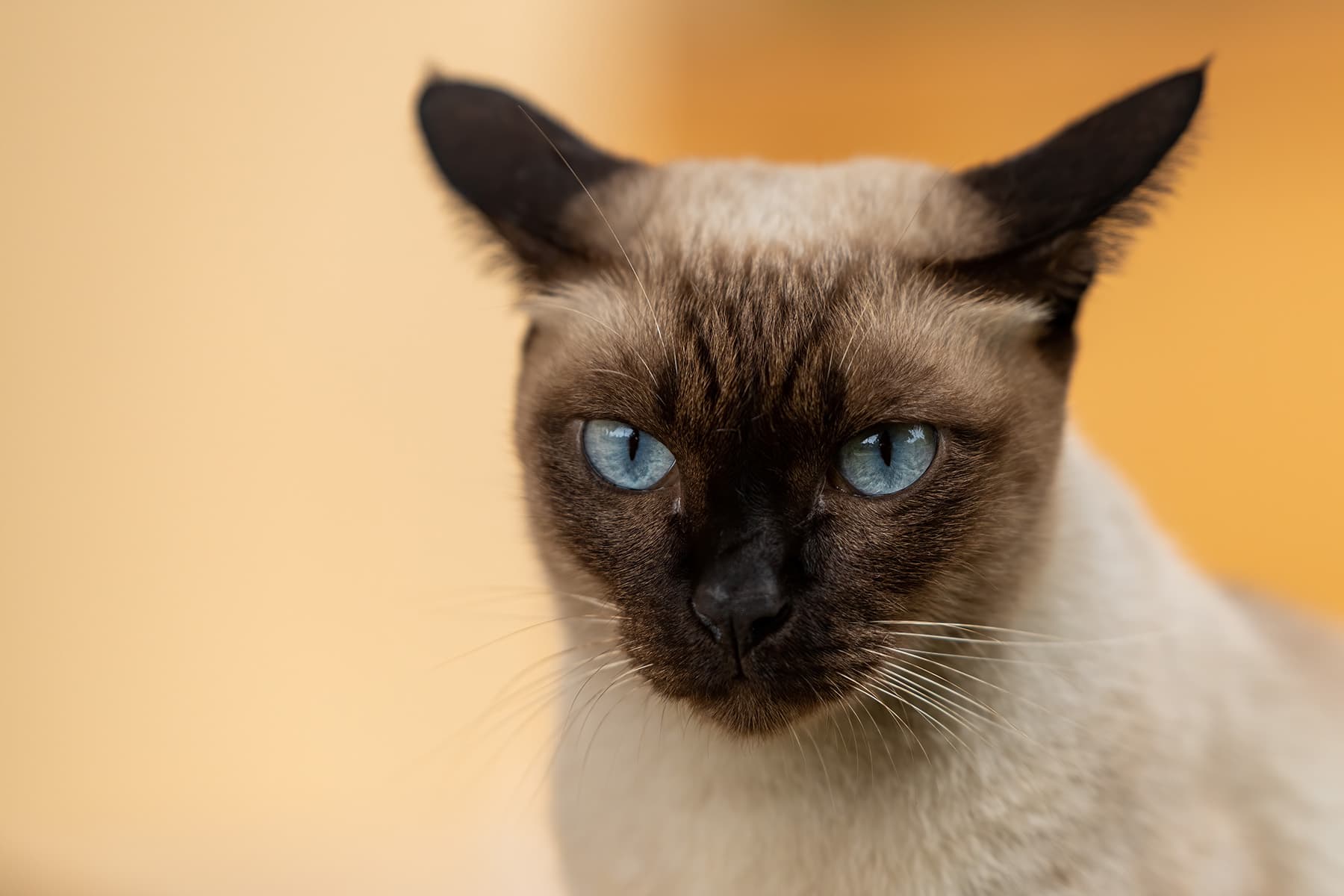
If you know Siam is an old name for Thailand, you may wonder why there are both Siamese and Thai breeds of cats. Both are pointed breeds. That means they have a particular color that is strongest in the face, ears, feet, and tail. You may have heard of a seal point, chocolate point, or blue point, although there are others too.
When Siamese cats came to the West, breeders soon set about emphasizing some of their characteristics. They bred for bluer eyes, slimmer bodies, and longer heads. The Thai is the Siamese cat before those changes. It's a native breed still found in Thailand today, with rounder cheeks and a less extreme silhouette. Thai cats are sometimes called old-style Siamese. The Thai name for the breed is Wichienmaat.
Thai Characteristics
Cat lovers don't agree about the Thai cat breed. The Cat Fanciers' Association (CFA) does not recognize any breed called Thai. The Governing Council of the Cat Fancy (GCCF), a British group, uses the term "Thai cats" for pointed versions of the Korat, the blue cat of Thailand.
The International Cat Club (TICA) recognizes the Old-Style Siamese under the breed name Thai. The TICA breed standard is the basis of the following description.
The Thai cat's head is a modified wedge with full cheeks and a flat forehead. The ears point more upward than outward, and the eyes are blue. Short hairs form a smooth coat that lies close to the body. The usual color of the coat is off-white. Points can be any color, but seal point, a dark blackish brown, is the most common. The ears, mask, feet, and tail must all match.
Thai cats are medium to large in size, with females weighing from 7 to 9 pounds and males weighing 9 to 12 pounds. They are long and graceful without having the extreme slimness of the Siamese. The breed standard compares the shape of the Thai to that of a small panther.
Like Siamese cats, Thais have a long life span. They may live into their late teens or early 20s.
Some people say that Thais have personalities much like the Siamese. They are both intelligent, curious, and active breeds. Thais like people and want to be with their owners, often greeting them at the door when they come home. They communicate with their owners vocally and through taps with their paws. If you want a quiet, cuddly cat, a Thai may not be the right fit. But if you want a lively companion, consider a Thai.
Caring for a Thai
Thai cats may demand attention from their owners, but they don't need a lot of care. Grooming tasks include:
Coat care. Thais keep their short coats clean and well-groomed. You don't need to bother with baths or brushing unless your cat gets into something nasty.
Ear care. Most cats never need their ears cleaned. If you notice that your pet's ears have a bad odor, a discharge, or a wax buildup, cleaning may be necessary. Use a solution recommended by your veterinarian. Apply it with clean gauze or cotton balls, not with swabs, which may injure the delicate tissues.
Dental care. By the time they are 3, most cats have some periodontal disease. Brush your cat's teeth regularly to avoid problems. Most cats can learn to accept tooth brushing. It's easier if you begin when your cat is young. Start with a swab dipped in the juice from canned tuna. Later, you can switch to a toothbrush and a pet toothpaste with an appetizing flavor. Daily brushing is best, but aim for at least three times a week.
Nail care. Trim your cat's nails every week or two. Your vet can show you how.
Providing a safe and comfortable environment for your cat is also fairly simple. Your cat will need:
Food. High-quality food is important for your Thai cat. Most adult cats should have two meals a day. If you leave dry food out for on-demand feeding, be sure your cat is drinking enough to make up for the lack of moisture in the food. Keep your cat at a healthy weight. Restrict treats to one or two a day. Talk to your vet if you have questions about the right diet for your cat.
Water. Water is just as important as food for your cat's health. Clean the water bowl often, and change the water at least once a day. Your cat may not drink if the water is stale. Some cats enjoy using a cat water fountain.
Litter boxes. Cats often refuse to use litter boxes that aren't cleaned regularly. Daily removal of solid waste and a good weekly cleaning should keep your pet happy. Clumping litter doesn't need to be changed as often. Don't use strongly scented cleaners on the litter box. Also avoid moving the box, as cats are creatures of habit.
Exercise. You don't have to entice Thai cats to be active, but they will appreciate perches, cat trees, and exercise wheels. Cat toys like feather teasers or fishing poles will encourage them to stretch and jump. Balls can provide hours of fun. A scratching post satisfies cats' natural desire to use their claws.
Temperature sensitivity. Thai cats have relatively thin coats. Your cat will enjoy a bed covered with a towel or blanket and placed in a warm spot. Wash the bedding often.
Indoor living.Indoor cats live longer than outdoor cats. Cats that are allowed outdoors can pick up diseases and parasites. They may be attacked by dogs, raccoons, coyotes, and other cats. They're also at risk of being hit by cars.
Just like humans, cats need high-quality health care. They need both preventive care and attention when they are sick or injured.
Vet visits. Your cat should have a wellness check once or twice a year. Your vet will perform a physical exam and order routine tests. Ask your vet about screening your cat for feline immunodeficiency virus (FIV) and feline leukemia virus (FeLV).
Vaccinations. All cats should receive core vaccinations.Core vaccines guard against rabies, feline panleukopenia (FPL), feline herpes virus type 1 (FHV-1), and feline calicivirus. Noncore vaccines for diseases like feline leukemia are also available. Your vet may suggest noncore vaccines based on your cat’s lifestyle and other risks.
Protection against fleas and ticks. Even indoor cats can have fleas and ticks. These pests can be a health hazard for your cat, as well as a nuisance. Your vet can help you prevent flea and tick problems.
Protection against worms. Cats should take year-round medication to prevent heartworms. Heartworm prevention is important because there is no treatment for heartworms in cats. Ask your vet if your pet needs screening or treatment for other types of worms.
Health Problems to Watch for With a Thai
Thais are a healthy breed with no known genetic problems. Your cat should live a long, healthy life with proper vaccines and other routine care.
You will also need to avoid these common problems:
Dental problems. Most cats over 4 years of age have problems with their teeth and gums. Only about 10% of cats will avoid dental problems for their whole life. Some purebred cats are especially at risk. Dental problems can be serious because infections in the mouth can spread to other parts of the body. Also, a sore mouth may keep your cat from eating. Brushing your cat's teeth can help. Have your vet check your pet's teeth regularly.
Obesity. Fat cats may be cuddly, but obesity in cats is a serious problem. About 40% of cats are obese, which means they weigh at least 20% more than they should. An obese cat won't be as active as it needs to be. Obesity can lead to other serious health problems, including:
- Osteoarthritis
- Hip dysplasia
- Cardiovascular disease
- Diabetes
Special Considerations for a Thai
Thai cats can be wonderful companions, but no breed is right for everyone. The breed has these positive points:
- Coat care. Thais seldom need grooming or bathing.
- Shedding. The smooth coat of the Thai doesn't shed much.
- Child-friendly. Thais make great pets for older children. Supervise young children around cats.
- Pet-friendly. Thais often enjoy having another cat in the household.
- Intelligent. Thai cats are smart and love interacting with their owners.
You should also know these facts about Thais:
- Need company. Thais are fond of their humans and don't like being left alone.
- Vocal. They meow a lot and produce a variety of sounds.
- Mischievous. Thais get into everything and also like jumping and climbing.
History of the Thai
In Thailand, cats are more than pets. They have ceremonial roles in Thai life. According to tradition, a cat must be carried into a new house before the family can move in. A cat is even part of the ceremony crowning a new king. It's no wonder that several cat breeds originated in this nation in Southeast Asia.
For at least 700 years, Thailand has been home to a pointed breed that the people call the Wichienmaat. The world's oldest book about cats, now in the National Library in Bangkok, describes these cats. Similar cats appear in old paintings of the royal family.
In the 1800s, the British discovered the Wichienmaat. Taken by their blue eyes and striking coloration, they took them home to Britain and called them Siamese cats.
As time went by, some breeders tried to intensify the blue shade of the Siamese eyes. They also exaggerated the cat's shape, developing cats with finer bones, a slimmer body, and a longer head.
By the 1950s, the long, lean Siamese with the pointed face was winning cat shows, while judges overlooked the cat with the round cheeks and more moderate shape. But some people still preferred the look of the original Siamese breed. Soon they organized breed clubs dedicated to preserving the older style of Siamese. They imported Wichienmaat cats from Thailand to create a healthy gene pool.
In 1990, the World Cat Federation recognized the breed and changed the name to Thai, distinguishing it from the new-style Siamese. Several other organizations dedicated to cats have followed suit.


